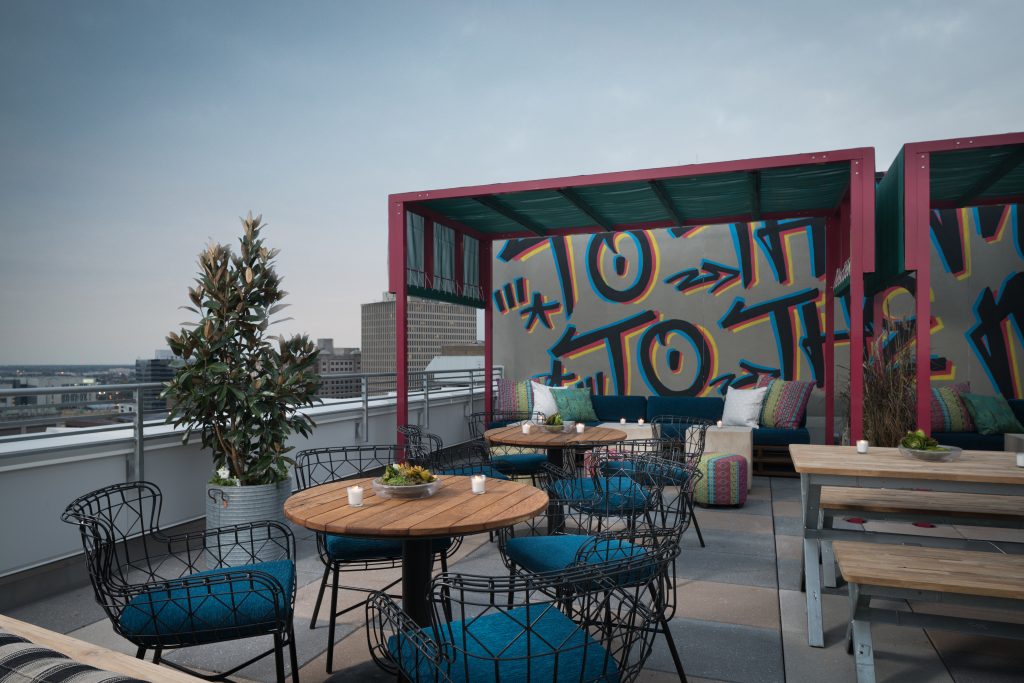The city in the fishbowl of the Mississippi River is getting a few more glances from the top of its tank with the recent increase in the number of rooftop bars across New Orleans.
Since 2016, a flurry of new rooftop bars have opened starting with Alto at the Ace Hotel, and followed by the Rooftop Terrace at the Catahoula Hotel, Hot Tin at the Pontchartrain Hotel, Monkey Board at The Troubadour and, as of July 10, Above the Grid at the NOPSI Hotel. The bars bookending this trend thus far, Alto and Above the Grid, also feature swimming pools.
Each of these hotels makes their home in the Central Business District, with the exception of The Pontchartrain Hotel, an establishment that remains in its historic location on St. Charles Avenue.
Cooper Manning, senior managing director of investor relations at the Chicago-based AJ Capital Partners, said he hopes Hot Tin’s location outside of visitors’ normal downtown enclave will help bring tourists and their business to different parts of the city.
“If you walk out The Pontchartrain’s front door, I think patrons are more likely to go to the right than used to be jumping to go left downtown,” Manning said. “So I think the clothing shops, cool bars, restaurants and breakfast spots up and down Magazine, and even further Uptown, are probably getting a little more love than they would otherwise/”
Wayne Hendricks, general manager of The Troubadour, said he has seen “a lot more foot traffic in the CBD” since the opening of The Troubadour and its accompanying Monkey Board rooftop br.
In addition to bringing tourists to new locations, both Manning and Hendricks said they wanted their rooftops to attract locals as well, making their bars a place where New Orleans residents can cohabitate.
“The vision for Monkey Board is for it to remain a neighborhood hangout that offers something for everyone,” Hendricks said.
As tourists venture off Bourbon Street, they enter into the purview of local New Orleanians. This migration has indeed created a space where one can find locals and non-locals intermingling. A visit to any of these bars on any given day will likely show a merging of these previously separate spheres over special views and specialty cocktails.
Furthermore, it’s not only one type of New Orleanian who attends these bars, but people of different ages from different neighborhoods, all of whom are willing to pay $10 for a cocktail.
“We’ve been thrilled with the mix. Young, old, locals, travelers, kind of all walks have been patrons,” Manning said. “I think the fact that, at 10:30 p.m., my parents can go up there and have a drink and see friends at the same time some 25-year-olds are up there too. They kind of keep them young, and then it keeps it cool for everybody.”
As a neighbor of The Pontchartrain Hotel, Avenue Pub owner Polly Watts thinks the new crop of rooftop bars is a “great trend.”
While she said that she thinks New Orleans is experiencing “a huge boom in drinking and eating establishments” that she is not sure is sustainable with the current wages and supply of quality staff, she said the integration of different parts and different people of the city is a good thing.
“I think it’s good for the city,” Watts said. “I think it’s good for tourism. Quite frankly, anything that gets people out of that sort of exclusively focused Bourbon Street mentality is a good thing for the city because the city has a lot more to offer than just Bourbon Street.”
While New Orleans did have a few rooftop spots before—like the seasonal rooftop bar and year-around pool atop The Roosevelt—the recent increase represents a marked growth spurt for the skyline establishments. Like the Pontchartrain Hotel, each of these hotels has a been developed largely by outside investors, with the exception of The Catahoula Hotel developed by Ley Line Development. Watts said the outside perspective these non-local companies brought with them may be exactly what allowed them to see the potential for rooftop bars. Manning echoed her perspective.
“I think New Orleans has a tendency, sometimes, to be pretty inflexible,” Manning said. “They like things how they were and stick to what’s worked for a long time because we were pretty confident in our ability to host events and throw a party. So this just adds a new wrinkle to what we probably hadn’t had in the past. And I think we are recognizing that locals like it, the travelers like it, and it works. So why not bend the rules a little bit? We’ve been known to do that as well.”




